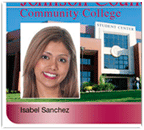
Community colleges haven’t always been considered ideal candidates for campus banking services. That’s changing. Partnerships between banks and the two-year schools through their student ID cards, are out there and brick and mortar facilities are showing up on campus as well.
CR80News’ 2008 campus card banking partners survey identified at least 10 partnerships between banks and ID programs at community colleges or community college districts.
Still, community colleges and their bank partners face challenges.
Since many community colleges don’t require a student to obtain an ID card, banks and colleges have to come up with ways to make the card attractive to students. Linking it to a bank is one of those ways because it means additional services, such as ATM and debit card capability.
Another challenge is that since community college students are typically older than those attending four-year schools, many students are already tethered to a bank and are reluctant to change.
 Johnson County Community College, Overland Park, Kan., only recently added banking services to its campus card. “We wanted to offer as many services to the students as we could related to the card,” said Susan W. Rider, manager of the Business Office Services at Johnson County. “Many students are commuters which means they often do business off campus for things like food and supplies. Having the card as a debit card lets the students receive their financial aid and refunds direct deposited and have the ability to use those funds off campus quickly.”
Johnson County Community College, Overland Park, Kan., only recently added banking services to its campus card. “We wanted to offer as many services to the students as we could related to the card,” said Susan W. Rider, manager of the Business Office Services at Johnson County. “Many students are commuters which means they often do business off campus for things like food and supplies. Having the card as a debit card lets the students receive their financial aid and refunds direct deposited and have the ability to use those funds off campus quickly.”
Rider feels that a banking relationship “is an excellent way for young adults or un-bankable students to get a free checking account through U.S. Bank. This allows students to use our direct deposit service to receive funds into their checking account quickly.”
“Offer the ID card at a community college may not perform as many functions as a four-year school’s ID card,” she says. “Since there’s normally no on-campus housing and limited meal plans many students may not see the ID card at a community college as a necessity.”
That’s why, she adds, banks “have to do a better job promoting all aspects of the ID card at a community college, not just the banking functions, so students see the value in having and using the card.”
Since most community college students don’t live on campus, they don’t spend as much time there as they would at a four-year school. “They may not see the traditional marketing pieces, such as flyers, posters and banners that we use to promote an ID card program,” says Bright. “Therefore, we are also using more electronic media to market to the community college students, e-mail, Web site announcements, etc.”
The atypical CC student
There’s also the issue of timing. Many community colleges don’t have typical summer or fall orientations. “If they don’t have a traditional orientation, we are scheduling regular tabling events through out the year to get the word out and open accounts for students,” adds Bright.
A bank can’t use all the same marketing tactics it utilizes at a four-year school. There are some major differences, says Whitney Bright, vice president and general manager for campus banking at U.S. Bank.
Freebies
Free services can help a banking partnership take. Among the free services at Johnson Community College, are Internet banking, the first box of checks, U.S. Bank Internet bill pay, four non-U.S. Bank ATM transactions per month and free U.S. Bank ATM transactions, says Rider.
The partnership with U.S. Bank is still new. “We completed the RFP process and started the partnership and implementation late last year,” says Rider. “We went live with the card and debit capability in May of this year.”
Already 3,500 students of the school’s 19,000 students have signed up, Laura Radke, systems specialist for Johnson Community College, expects a rush of new card applications this fall as the students return for the new year. “Technically we do not require every student to have (a student ID), but whenever possible we highly encourage our students and staff to get their new ID card,” says Radke. “I believe most of our students will be getting their cards in the fall after the fall payment deadline.”
As to the program’s success, Radke says it is off to a great start. “Both students and staff have easily converted over to the new Johnson Community College ID card with minimal issues. This is something the students have been wanting, and now that we have the baseline functionality in place, we will be working to build-up the card program to offer new functionality and services to best meet the needs of our student/staff population.”
Help for the bottom line
Wells Fargo currently supports Campus Card services at several community colleges, as well.
“We began working with community colleges in 2005 because we were able to provide an important and valued service for students, faculty and staff,” says Richele Messick, Wells Fargo Corporate Communications.
The bank has an on-campus presence at one of the community colleges it services, Riverside Community College in California, including three ATMs, one on each of its campuses. “We do not have stores (branch banks) or ATMs at the other two community colleges. Each school relationship as well as the needs of the school is different,” adds Messick. “We work with our customers to determine how we can best serve their financial services needs.”
The free checking with no monthly minimum balance and ATMs on campus were also additions to Riverside Community College in California, says Linda Lacy, vice chancellor of student services and operations. The college has been with Wells Fargo for more about two and a half years. With a branch bank on site, it means Wells Fargo staff are always visible, says Lacy.
As with any banking partnership, there’s also its effects on the college’s bottom line. “The Wells Fargo program provides royalty payments to the college which funds the cost of providing the card and administrative fees involved in this process,” says Lacy. “The card serves as the students library card, access to labs, provides identification for the GO PASS program which allows RCC students to ride Riverside Transit Authority buses free and discount programs with local businesses.”
The ID card program at Riverside is also voluntary. Still, thanks to extensive promotions by both the college and Wells Fargo–information tables, press releases to the student newspaper, ads in the summer class schedule and in the student handbook–Lacy estimates that nearly 90% of the college’s 37,000 students have received their ID cards.
One bank leaves, another enters
Things worked a little differently for Milwaukee Area Technical College, another U.S. Bank partner school. For one, it wasn’t a matter of starting a new program. It was replacing one bank with another.
Brenda Saugstad, coordinator of campus card programs and services for Milwaukee Area Technical College, sought out another bank after its partnership of four years was terminated by TCF Bank, which told her it was losing money on the deal.
“We tried our best to make it work,” says Jason Korstange, TCF’s director of corporate communications. “It was not something we could see working out on a long term basis.”
“U.S. Bank is in our area and has branches in our surrounding areas to meet the needs of students at each of our campuses,” says Saugstad. The center has four campuses in the Milwaukee area serving some 50,000 students, all commuters. The average age of its students is 28.
The school’s former bank had a brick and mortar facility at one of the campuses which U.S. Bank will be taking over, says Saugstad.
The first major chore, she says, will be recarding all students starting this fall. U.S. Bank will pay the recarding expenses and will promote the changeover in an effort to get students to open up accounts, says Saugstad.
Free services are similar to those offered at Johnson County and while an ID card isn’t mandatory, about three fourths of the students do have one, says Saugstad. However, the percentage is less than 50% on the number of students who had accounts with the school’s former bank.
“The advantages (of a banking relationship) are wonderful,” says Saugstad. “Students can do banking right here while at school. They don’t have to worry about having to get to a bank to make deposits or finding the transportation to get there,” she says.




